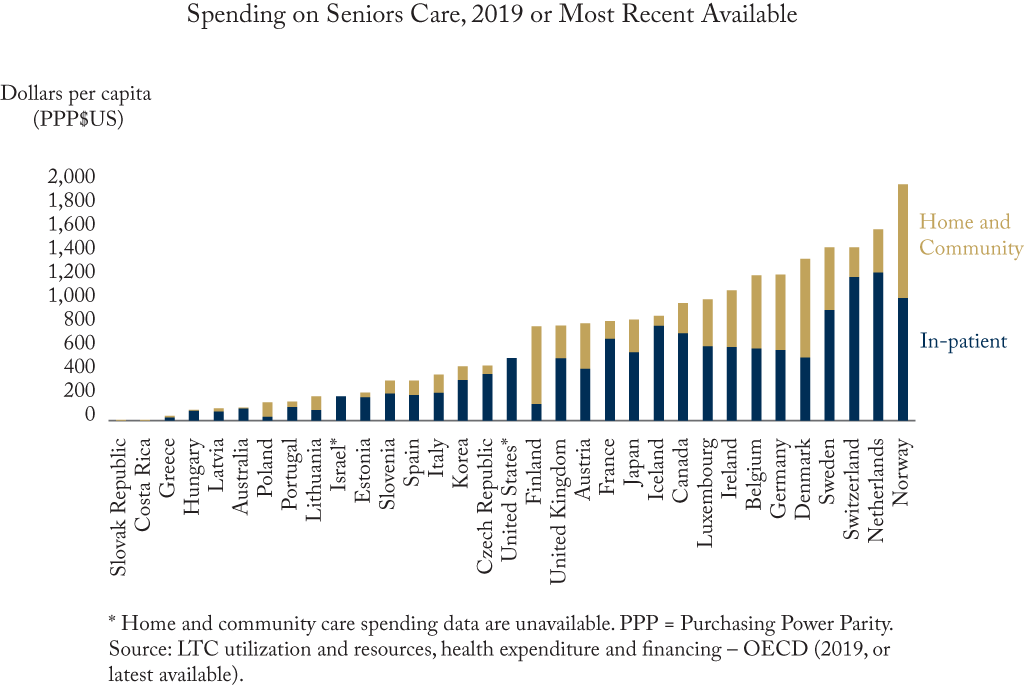Post-Budget Briefing with Chris Forbes, Deputy Minister of Finance Canada
Submitted by Adi.Malev onC.D. Howe Institute events and webinars are open to members and their guests.
Please follow this link or contact amalev@cdhowe.org to register.
C.D. Howe Institute
67 Yonge Street, Suite 300
Toronto ON M5E 1J8
Canada
Portable Heath Benefits Plan with Chris Bonnett and Rosalie Wyonch
One in three Ontarians do not have access to workplace health and dental benefits. In its Commentary titled "Better for Workers, Better for All? Assessing a Portable Health Benefits Plan in Ontario," the C.D. Howe Institute investigates a possible solution for that almost 30% of those in the province who need coverage.
Annual Report on Giving - 2022
Submitted by Lauren.Malyk onCaring for Canada's Seniors
We need to change the way we care for our elderly.
Across the country, Canada's healthcare systems need structural change to offer our seniors better care outcomes and care options that work for them.
It’s time we re-evaluate how our healthcare system treats our seniors. Better is possible.
Moving Forward After COVID-19
COVID-19 strained an already dysfunctional seniors’ healthcare system, leaving many elderly Canadians in unreliable and sometimes tragic conditions. As Canada's population ages, our healthcare system will undergo increased strain — with too many seniors stuck in hospitals receiving aggressive, acute care.

Ounce of Prevention is Worth a Pound of Cure: Seniors' Care After COVID-19
Prior to the pandemic, Canada had long waitlists for long-term care homes and had fewer homecare providers than the international average. These existing shortfalls will be compounded by Canada’s ageing population as babyboomers surpass 80 years of age. Making necessary changes to improve the quality of long-term care — such as reducing occupancy per room, increasing staffing levels, supporting higher wages for care workers, constructing new facilities — would require nearly every new dollar of health spending be directed to seniors care, with annual costs projected to increase to 4.2 percent of GDP by 2040. This level of investment in seniors’ care is unprecedented and fiscally infeasible. Innovative approaches will be required.
Read the Report
Expensive Endings: Reining In the High Cost of End-of-Life Care in Canada
Despite spending more on medical care delivered at the end-of-life than other high-income countries, Canada performs poorly on most measures of healthcare quality – meaning Canadians are not getting value for their money.
With a few simple, feasible structural changes in end-of-life care, Canada’s healthcare system could save hundreds of millions of dollars annually. Canada has among the highest rates of hospitalization in the last three months of life (61 percent), despite the vast majority of Canadians (87 percent) preferring to receive end of life care at home. As well, most Canadians die in hospital (61 percent), far more than in England (47 to 51 percent), the Netherlands (28 to 31 percent) and the United States (20 percent).
Read the ReportCanada Underinvests In Community Care

Canada’s per capita spending on homecare and other outpatient and day program services falls below the international average. In general, countries that direct higher proportions of health spending to seniors care than Canada also spend more per capita on home care, outpatient care and day programs for seniors.
Overall, long term care in Canada appears to be slightly above average in terms of spending, number of beds relative to population size, and proportion of the population receiving care, but slightly below average in terms of investment on home and community care. While its total spending is above average, Canada doesn’t rank among the top countries on any of these factors. In fact, waitlists and shortages for institutional care beds are common, resulting in inefficient use of hospital resources.
By shifting more resources to community care, Canadian seniors can receive care that is more in line with their needs and wants, while making more efficient use of healthcare spending.
Learn more
Canada's Sky-High Cost for End of Life Care
If most Canadians want to die at home, why don’t we? Two out of three will die in a hospital and the cost is enormous. Doctors James Downar and Kieran Quinn offer solutions to cut costs and give us the end of life we want.
Sign up for updates
Want to get the latest research from the C.D. Howe Institute? Sign up below to get Canada's trusted policy intelligence.

Learn More about C.D. Howe Institute Ideas to Change Care Models in Canada

Shifting Towards Autonomy: A Continuing Care Model for Canada
Canadians would benefit from a new funding model for elder care.
Canadian provinces can learn important lessons from debates and reforms in other developed countries, specifically when it comes to offering individuals the option to receive a payment, or a cash voucher, allowing them to choose from a menu of services that are delivered where they want them.
Read the Report
Prioritize Problems Before Politics to Modernize Seniors Care in Canada
COVID exposed the inadequacies of existing conditions in seniors care and emerging issues related to improving infection prevention and control. Among them: reducing occupancy per room; increasing staffing levels to provide surge capacity and care continuity during crisis situations; and ensuring staff are trained and prepared to rapidly implement infectious disease protocols.
Achieving these changes, however, will require significant infrastructure upgrade investments, constructing new facilities, as well as paying higher wages to more workers.
Read the ReportFrom: Chris Bonnett
To: Pharmacare Watchers
Date: April 7, 2022
Re: The Phoenix of National Pharmacare
The Liberal-New Democratic Party agreement last month contained four healthcare goals: Universal national pharmacare, an income-tested dental care program, a Safe Long-Term Care Act and intergovernmental cooperation to improve health outcomes.
5G Rollout Requires Expanded Access to Infrastructure, Regulatory Framework Update
January 13, 2022 – The future economic and social benefits of Canada’s next-generation broadband networks rely on timely and reasonable access to the “passive infrastructure,” from rooftops to bus stops and rights of way, that supports wireline and wireless telecommunications network facilities, according to a new report from the C.D. Howe Institute.
Is 2022 the year crypto becomes money? – Financial Post Op-Ed
The world got its first digital currency, DigiCash, in 1989. Nine years later it filed for bankruptcy. Since then the world has been waiting for digital currency to take over from cash – as it seems bound at some stage to do. Is 2022 the year it finally happens?
To: Canadian Ministers of Education
From: Clare Halloran, Rebecca Jack, James C. Okun, and Emily Oster
Re: The Effect of Online Learning on Student Performance: Evidence from US States
Date: January 5, 2022
From: Harvey Naglie
To: Central Bank Observers
Date: December 20, 2021
Re: Hit Pause on Ontario’s Proposed Capital Markets Act
From: David Laidler
To: Central Bank Observers
Date: December 10, 2021
Re: Freeing the Bank of Canada from its Own Trap
It was 50 years ago that I first heard the gibe that “central bankers think inflation is always and everywhere a monetary phenomenon – except this time, of course,” and it remains as good as new.
Consider the Bank of Canada, now caught in a trap of its own making.

